Sports Psychology Report: Cricket, Goals, and Mental Strategies
VerifiedAdded on 2023/06/09
|8
|2228
|241
Report
AI Summary
This report delves into the realm of sports psychology, examining its critical role in athletic performance. It begins by highlighting the importance of sports, specifically focusing on cricket, and the factors that encourage participation, such as parental support and venue accessibility. The report then explores the significance of goal setting in sports, differentiating between outcome, performance, and process goals, while emphasizing the use of the SMART goal model. Furthermore, it addresses the psychological aspects of sports, discussing anxiety, arousal, and stress, and their impact on an athlete's performance. It elucidates the differences between positive and negative stress, and trait and state anxiety, along with various techniques for managing arousal, such as biofeedback and relaxation methods. The report concludes by discussing the development of mental toughness, the factors contributing to it, and strategies to cultivate it, including training for adversity, and self-acceptance. Overall, the report provides a comprehensive overview of how psychological principles can be applied to enhance athletic performance and promote mental resilience in sports.

Sports psychology
Paraphrase This Document
Need a fresh take? Get an instant paraphrase of this document with our AI Paraphraser

Table of Contents
INTRODUCTION...........................................................................................................................3
QUESTION 1...................................................................................................................................3
QUESTION 2...................................................................................................................................4
QUESTION 3...................................................................................................................................5
QUESTION 4...................................................................................................................................6
CONCLUSION................................................................................................................................7
INTRODUCTION...........................................................................................................................3
QUESTION 1...................................................................................................................................3
QUESTION 2...................................................................................................................................4
QUESTION 3...................................................................................................................................5
QUESTION 4...................................................................................................................................6
CONCLUSION................................................................................................................................7
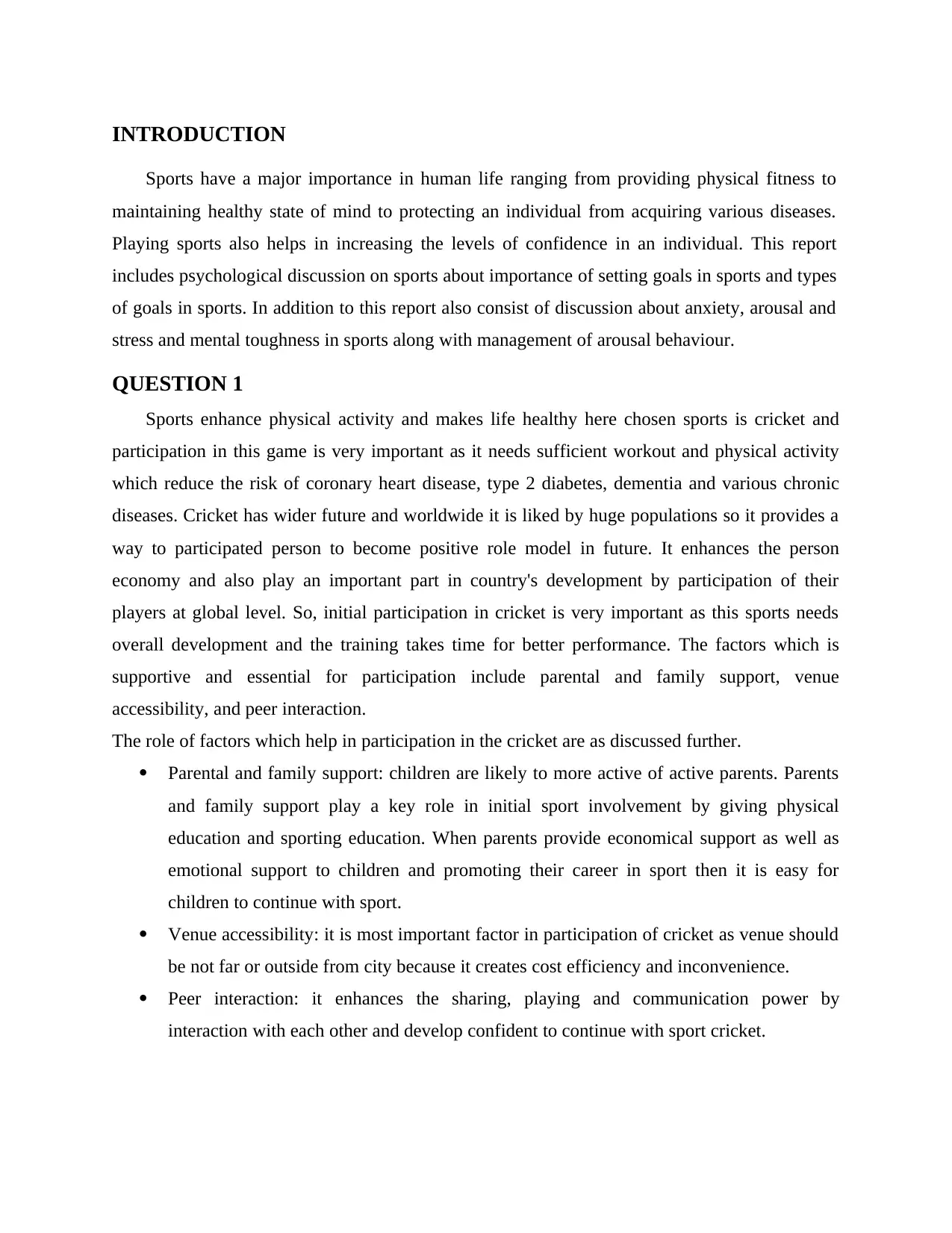
INTRODUCTION
Sports have a major importance in human life ranging from providing physical fitness to
maintaining healthy state of mind to protecting an individual from acquiring various diseases.
Playing sports also helps in increasing the levels of confidence in an individual. This report
includes psychological discussion on sports about importance of setting goals in sports and types
of goals in sports. In addition to this report also consist of discussion about anxiety, arousal and
stress and mental toughness in sports along with management of arousal behaviour.
QUESTION 1
Sports enhance physical activity and makes life healthy here chosen sports is cricket and
participation in this game is very important as it needs sufficient workout and physical activity
which reduce the risk of coronary heart disease, type 2 diabetes, dementia and various chronic
diseases. Cricket has wider future and worldwide it is liked by huge populations so it provides a
way to participated person to become positive role model in future. It enhances the person
economy and also play an important part in country's development by participation of their
players at global level. So, initial participation in cricket is very important as this sports needs
overall development and the training takes time for better performance. The factors which is
supportive and essential for participation include parental and family support, venue
accessibility, and peer interaction.
The role of factors which help in participation in the cricket are as discussed further.
Parental and family support: children are likely to more active of active parents. Parents
and family support play a key role in initial sport involvement by giving physical
education and sporting education. When parents provide economical support as well as
emotional support to children and promoting their career in sport then it is easy for
children to continue with sport.
Venue accessibility: it is most important factor in participation of cricket as venue should
be not far or outside from city because it creates cost efficiency and inconvenience.
Peer interaction: it enhances the sharing, playing and communication power by
interaction with each other and develop confident to continue with sport cricket.
Sports have a major importance in human life ranging from providing physical fitness to
maintaining healthy state of mind to protecting an individual from acquiring various diseases.
Playing sports also helps in increasing the levels of confidence in an individual. This report
includes psychological discussion on sports about importance of setting goals in sports and types
of goals in sports. In addition to this report also consist of discussion about anxiety, arousal and
stress and mental toughness in sports along with management of arousal behaviour.
QUESTION 1
Sports enhance physical activity and makes life healthy here chosen sports is cricket and
participation in this game is very important as it needs sufficient workout and physical activity
which reduce the risk of coronary heart disease, type 2 diabetes, dementia and various chronic
diseases. Cricket has wider future and worldwide it is liked by huge populations so it provides a
way to participated person to become positive role model in future. It enhances the person
economy and also play an important part in country's development by participation of their
players at global level. So, initial participation in cricket is very important as this sports needs
overall development and the training takes time for better performance. The factors which is
supportive and essential for participation include parental and family support, venue
accessibility, and peer interaction.
The role of factors which help in participation in the cricket are as discussed further.
Parental and family support: children are likely to more active of active parents. Parents
and family support play a key role in initial sport involvement by giving physical
education and sporting education. When parents provide economical support as well as
emotional support to children and promoting their career in sport then it is easy for
children to continue with sport.
Venue accessibility: it is most important factor in participation of cricket as venue should
be not far or outside from city because it creates cost efficiency and inconvenience.
Peer interaction: it enhances the sharing, playing and communication power by
interaction with each other and develop confident to continue with sport cricket.
⊘ This is a preview!⊘
Do you want full access?
Subscribe today to unlock all pages.

Trusted by 1+ million students worldwide
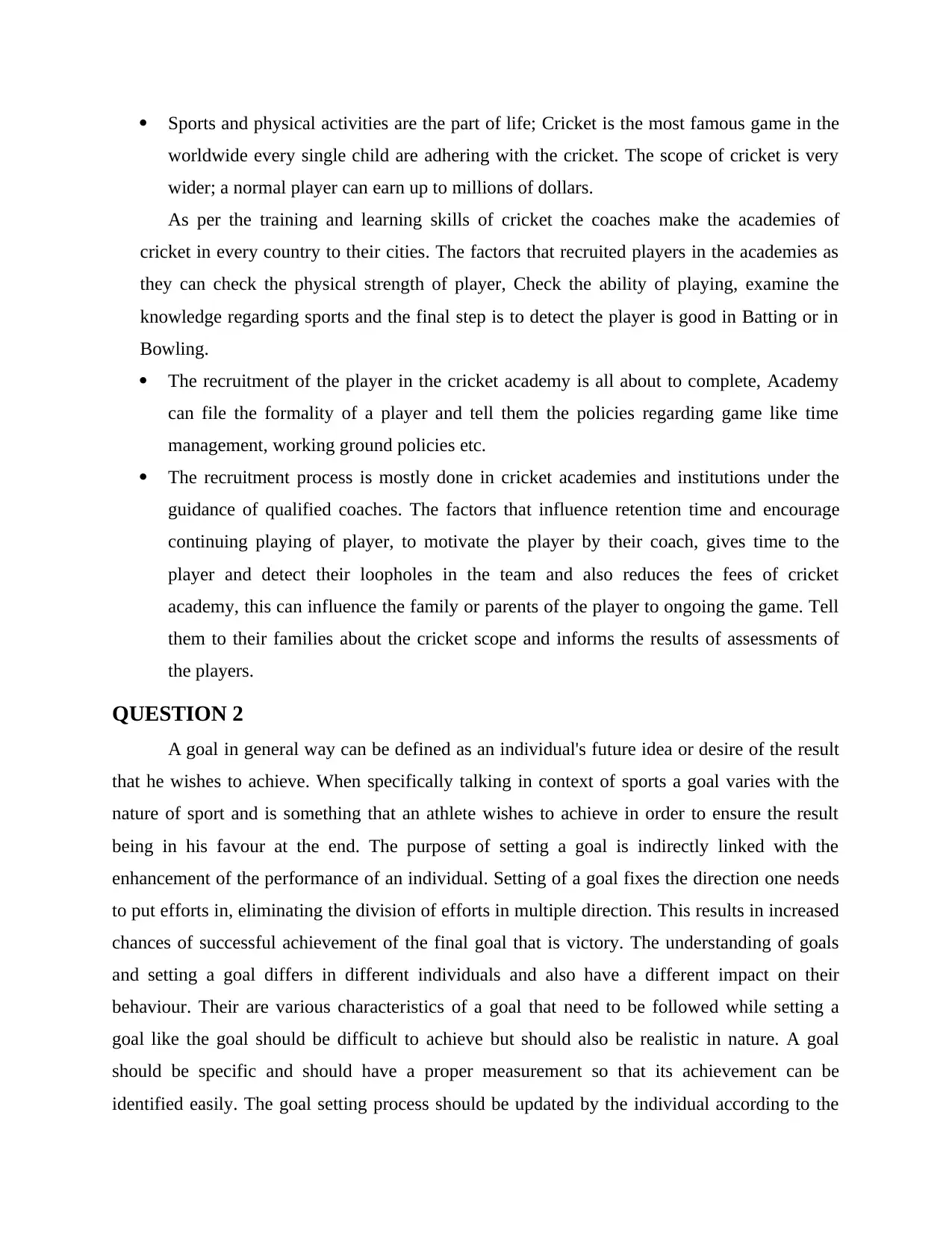
Sports and physical activities are the part of life; Cricket is the most famous game in the
worldwide every single child are adhering with the cricket. The scope of cricket is very
wider; a normal player can earn up to millions of dollars.
As per the training and learning skills of cricket the coaches make the academies of
cricket in every country to their cities. The factors that recruited players in the academies as
they can check the physical strength of player, Check the ability of playing, examine the
knowledge regarding sports and the final step is to detect the player is good in Batting or in
Bowling.
The recruitment of the player in the cricket academy is all about to complete, Academy
can file the formality of a player and tell them the policies regarding game like time
management, working ground policies etc.
The recruitment process is mostly done in cricket academies and institutions under the
guidance of qualified coaches. The factors that influence retention time and encourage
continuing playing of player, to motivate the player by their coach, gives time to the
player and detect their loopholes in the team and also reduces the fees of cricket
academy, this can influence the family or parents of the player to ongoing the game. Tell
them to their families about the cricket scope and informs the results of assessments of
the players.
QUESTION 2
A goal in general way can be defined as an individual's future idea or desire of the result
that he wishes to achieve. When specifically talking in context of sports a goal varies with the
nature of sport and is something that an athlete wishes to achieve in order to ensure the result
being in his favour at the end. The purpose of setting a goal is indirectly linked with the
enhancement of the performance of an individual. Setting of a goal fixes the direction one needs
to put efforts in, eliminating the division of efforts in multiple direction. This results in increased
chances of successful achievement of the final goal that is victory. The understanding of goals
and setting a goal differs in different individuals and also have a different impact on their
behaviour. Their are various characteristics of a goal that need to be followed while setting a
goal like the goal should be difficult to achieve but should also be realistic in nature. A goal
should be specific and should have a proper measurement so that its achievement can be
identified easily. The goal setting process should be updated by the individual according to the
worldwide every single child are adhering with the cricket. The scope of cricket is very
wider; a normal player can earn up to millions of dollars.
As per the training and learning skills of cricket the coaches make the academies of
cricket in every country to their cities. The factors that recruited players in the academies as
they can check the physical strength of player, Check the ability of playing, examine the
knowledge regarding sports and the final step is to detect the player is good in Batting or in
Bowling.
The recruitment of the player in the cricket academy is all about to complete, Academy
can file the formality of a player and tell them the policies regarding game like time
management, working ground policies etc.
The recruitment process is mostly done in cricket academies and institutions under the
guidance of qualified coaches. The factors that influence retention time and encourage
continuing playing of player, to motivate the player by their coach, gives time to the
player and detect their loopholes in the team and also reduces the fees of cricket
academy, this can influence the family or parents of the player to ongoing the game. Tell
them to their families about the cricket scope and informs the results of assessments of
the players.
QUESTION 2
A goal in general way can be defined as an individual's future idea or desire of the result
that he wishes to achieve. When specifically talking in context of sports a goal varies with the
nature of sport and is something that an athlete wishes to achieve in order to ensure the result
being in his favour at the end. The purpose of setting a goal is indirectly linked with the
enhancement of the performance of an individual. Setting of a goal fixes the direction one needs
to put efforts in, eliminating the division of efforts in multiple direction. This results in increased
chances of successful achievement of the final goal that is victory. The understanding of goals
and setting a goal differs in different individuals and also have a different impact on their
behaviour. Their are various characteristics of a goal that need to be followed while setting a
goal like the goal should be difficult to achieve but should also be realistic in nature. A goal
should be specific and should have a proper measurement so that its achievement can be
identified easily. The goal setting process should be updated by the individual according to the
Paraphrase This Document
Need a fresh take? Get an instant paraphrase of this document with our AI Paraphraser
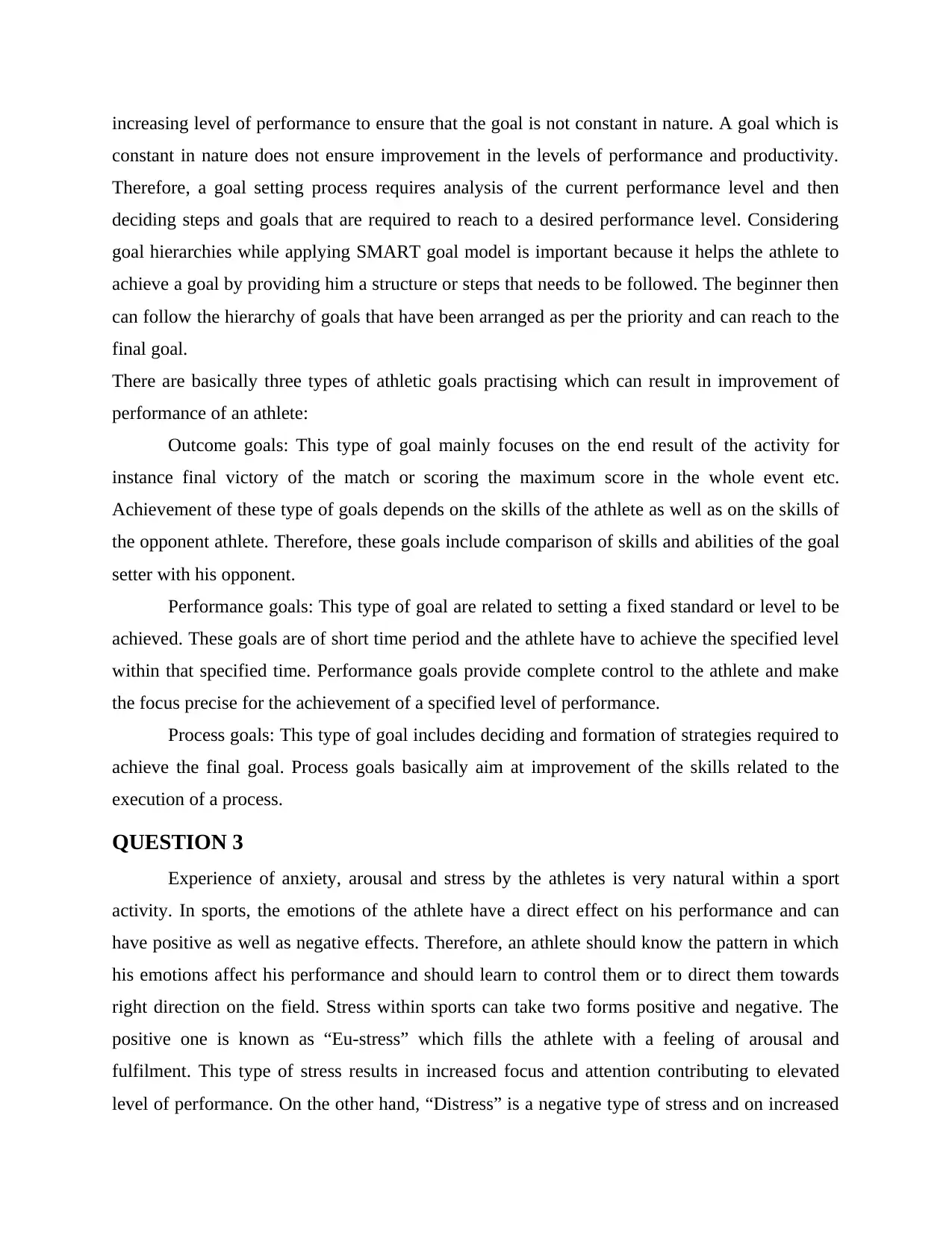
increasing level of performance to ensure that the goal is not constant in nature. A goal which is
constant in nature does not ensure improvement in the levels of performance and productivity.
Therefore, a goal setting process requires analysis of the current performance level and then
deciding steps and goals that are required to reach to a desired performance level. Considering
goal hierarchies while applying SMART goal model is important because it helps the athlete to
achieve a goal by providing him a structure or steps that needs to be followed. The beginner then
can follow the hierarchy of goals that have been arranged as per the priority and can reach to the
final goal.
There are basically three types of athletic goals practising which can result in improvement of
performance of an athlete:
Outcome goals: This type of goal mainly focuses on the end result of the activity for
instance final victory of the match or scoring the maximum score in the whole event etc.
Achievement of these type of goals depends on the skills of the athlete as well as on the skills of
the opponent athlete. Therefore, these goals include comparison of skills and abilities of the goal
setter with his opponent.
Performance goals: This type of goal are related to setting a fixed standard or level to be
achieved. These goals are of short time period and the athlete have to achieve the specified level
within that specified time. Performance goals provide complete control to the athlete and make
the focus precise for the achievement of a specified level of performance.
Process goals: This type of goal includes deciding and formation of strategies required to
achieve the final goal. Process goals basically aim at improvement of the skills related to the
execution of a process.
QUESTION 3
Experience of anxiety, arousal and stress by the athletes is very natural within a sport
activity. In sports, the emotions of the athlete have a direct effect on his performance and can
have positive as well as negative effects. Therefore, an athlete should know the pattern in which
his emotions affect his performance and should learn to control them or to direct them towards
right direction on the field. Stress within sports can take two forms positive and negative. The
positive one is known as “Eu-stress” which fills the athlete with a feeling of arousal and
fulfilment. This type of stress results in increased focus and attention contributing to elevated
level of performance. On the other hand, “Distress” is a negative type of stress and on increased
constant in nature does not ensure improvement in the levels of performance and productivity.
Therefore, a goal setting process requires analysis of the current performance level and then
deciding steps and goals that are required to reach to a desired performance level. Considering
goal hierarchies while applying SMART goal model is important because it helps the athlete to
achieve a goal by providing him a structure or steps that needs to be followed. The beginner then
can follow the hierarchy of goals that have been arranged as per the priority and can reach to the
final goal.
There are basically three types of athletic goals practising which can result in improvement of
performance of an athlete:
Outcome goals: This type of goal mainly focuses on the end result of the activity for
instance final victory of the match or scoring the maximum score in the whole event etc.
Achievement of these type of goals depends on the skills of the athlete as well as on the skills of
the opponent athlete. Therefore, these goals include comparison of skills and abilities of the goal
setter with his opponent.
Performance goals: This type of goal are related to setting a fixed standard or level to be
achieved. These goals are of short time period and the athlete have to achieve the specified level
within that specified time. Performance goals provide complete control to the athlete and make
the focus precise for the achievement of a specified level of performance.
Process goals: This type of goal includes deciding and formation of strategies required to
achieve the final goal. Process goals basically aim at improvement of the skills related to the
execution of a process.
QUESTION 3
Experience of anxiety, arousal and stress by the athletes is very natural within a sport
activity. In sports, the emotions of the athlete have a direct effect on his performance and can
have positive as well as negative effects. Therefore, an athlete should know the pattern in which
his emotions affect his performance and should learn to control them or to direct them towards
right direction on the field. Stress within sports can take two forms positive and negative. The
positive one is known as “Eu-stress” which fills the athlete with a feeling of arousal and
fulfilment. This type of stress results in increased focus and attention contributing to elevated
level of performance. On the other hand, “Distress” is a negative type of stress and on increased
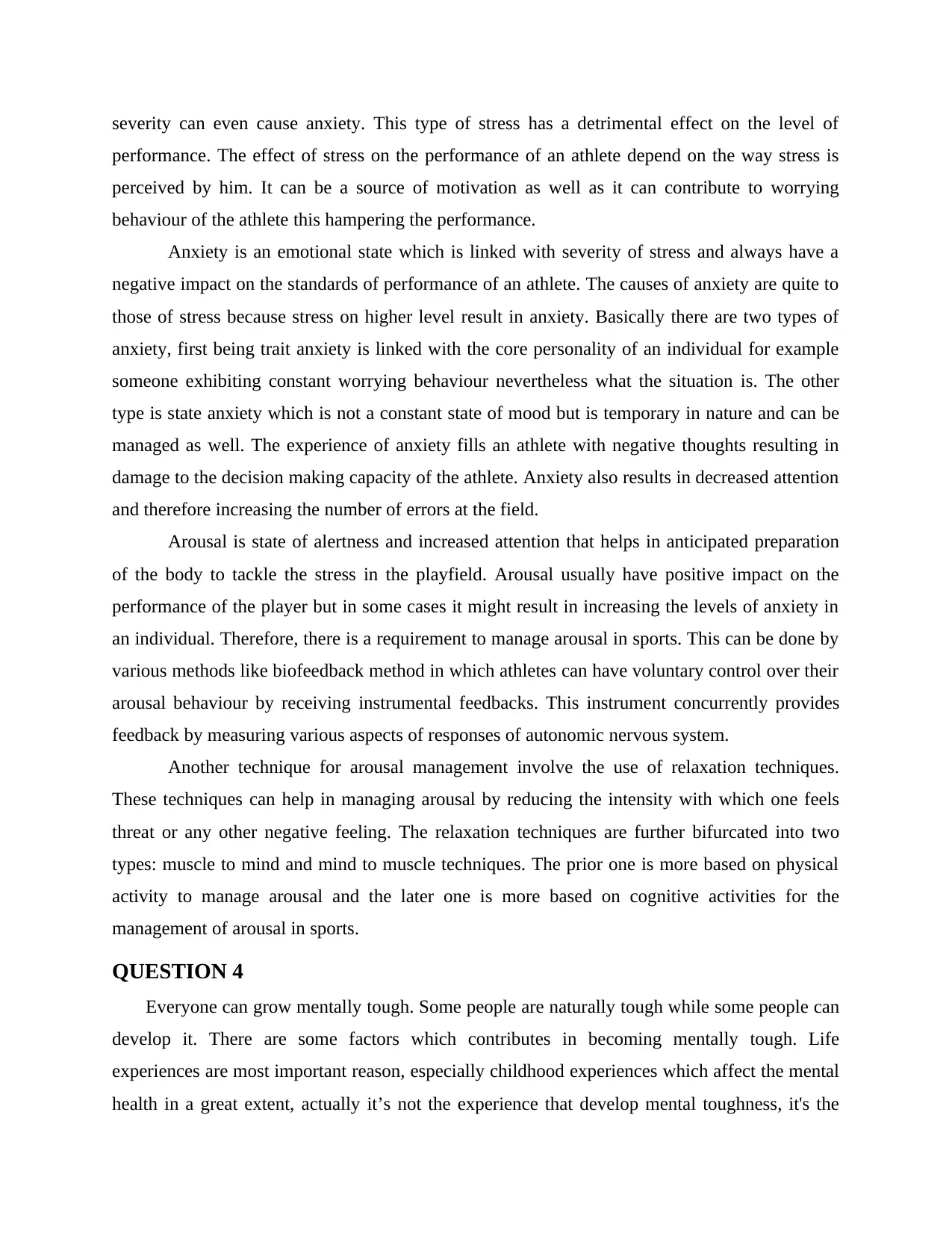
severity can even cause anxiety. This type of stress has a detrimental effect on the level of
performance. The effect of stress on the performance of an athlete depend on the way stress is
perceived by him. It can be a source of motivation as well as it can contribute to worrying
behaviour of the athlete this hampering the performance.
Anxiety is an emotional state which is linked with severity of stress and always have a
negative impact on the standards of performance of an athlete. The causes of anxiety are quite to
those of stress because stress on higher level result in anxiety. Basically there are two types of
anxiety, first being trait anxiety is linked with the core personality of an individual for example
someone exhibiting constant worrying behaviour nevertheless what the situation is. The other
type is state anxiety which is not a constant state of mood but is temporary in nature and can be
managed as well. The experience of anxiety fills an athlete with negative thoughts resulting in
damage to the decision making capacity of the athlete. Anxiety also results in decreased attention
and therefore increasing the number of errors at the field.
Arousal is state of alertness and increased attention that helps in anticipated preparation
of the body to tackle the stress in the playfield. Arousal usually have positive impact on the
performance of the player but in some cases it might result in increasing the levels of anxiety in
an individual. Therefore, there is a requirement to manage arousal in sports. This can be done by
various methods like biofeedback method in which athletes can have voluntary control over their
arousal behaviour by receiving instrumental feedbacks. This instrument concurrently provides
feedback by measuring various aspects of responses of autonomic nervous system.
Another technique for arousal management involve the use of relaxation techniques.
These techniques can help in managing arousal by reducing the intensity with which one feels
threat or any other negative feeling. The relaxation techniques are further bifurcated into two
types: muscle to mind and mind to muscle techniques. The prior one is more based on physical
activity to manage arousal and the later one is more based on cognitive activities for the
management of arousal in sports.
QUESTION 4
Everyone can grow mentally tough. Some people are naturally tough while some people can
develop it. There are some factors which contributes in becoming mentally tough. Life
experiences are most important reason, especially childhood experiences which affect the mental
health in a great extent, actually it’s not the experience that develop mental toughness, it's the
performance. The effect of stress on the performance of an athlete depend on the way stress is
perceived by him. It can be a source of motivation as well as it can contribute to worrying
behaviour of the athlete this hampering the performance.
Anxiety is an emotional state which is linked with severity of stress and always have a
negative impact on the standards of performance of an athlete. The causes of anxiety are quite to
those of stress because stress on higher level result in anxiety. Basically there are two types of
anxiety, first being trait anxiety is linked with the core personality of an individual for example
someone exhibiting constant worrying behaviour nevertheless what the situation is. The other
type is state anxiety which is not a constant state of mood but is temporary in nature and can be
managed as well. The experience of anxiety fills an athlete with negative thoughts resulting in
damage to the decision making capacity of the athlete. Anxiety also results in decreased attention
and therefore increasing the number of errors at the field.
Arousal is state of alertness and increased attention that helps in anticipated preparation
of the body to tackle the stress in the playfield. Arousal usually have positive impact on the
performance of the player but in some cases it might result in increasing the levels of anxiety in
an individual. Therefore, there is a requirement to manage arousal in sports. This can be done by
various methods like biofeedback method in which athletes can have voluntary control over their
arousal behaviour by receiving instrumental feedbacks. This instrument concurrently provides
feedback by measuring various aspects of responses of autonomic nervous system.
Another technique for arousal management involve the use of relaxation techniques.
These techniques can help in managing arousal by reducing the intensity with which one feels
threat or any other negative feeling. The relaxation techniques are further bifurcated into two
types: muscle to mind and mind to muscle techniques. The prior one is more based on physical
activity to manage arousal and the later one is more based on cognitive activities for the
management of arousal in sports.
QUESTION 4
Everyone can grow mentally tough. Some people are naturally tough while some people can
develop it. There are some factors which contributes in becoming mentally tough. Life
experiences are most important reason, especially childhood experiences which affect the mental
health in a great extent, actually it’s not the experience that develop mental toughness, it's the
⊘ This is a preview!⊘
Do you want full access?
Subscribe today to unlock all pages.

Trusted by 1+ million students worldwide
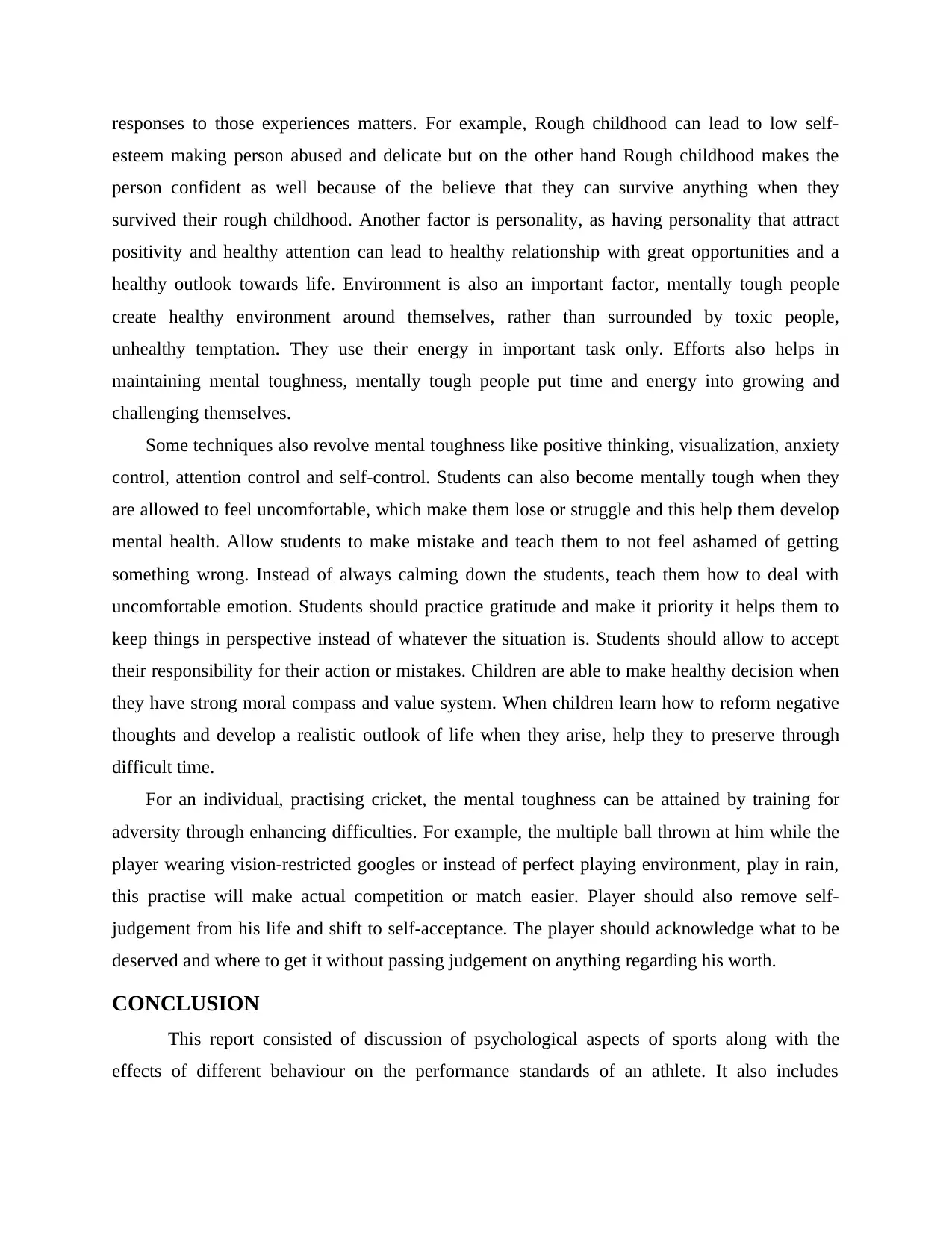
responses to those experiences matters. For example, Rough childhood can lead to low self-
esteem making person abused and delicate but on the other hand Rough childhood makes the
person confident as well because of the believe that they can survive anything when they
survived their rough childhood. Another factor is personality, as having personality that attract
positivity and healthy attention can lead to healthy relationship with great opportunities and a
healthy outlook towards life. Environment is also an important factor, mentally tough people
create healthy environment around themselves, rather than surrounded by toxic people,
unhealthy temptation. They use their energy in important task only. Efforts also helps in
maintaining mental toughness, mentally tough people put time and energy into growing and
challenging themselves.
Some techniques also revolve mental toughness like positive thinking, visualization, anxiety
control, attention control and self-control. Students can also become mentally tough when they
are allowed to feel uncomfortable, which make them lose or struggle and this help them develop
mental health. Allow students to make mistake and teach them to not feel ashamed of getting
something wrong. Instead of always calming down the students, teach them how to deal with
uncomfortable emotion. Students should practice gratitude and make it priority it helps them to
keep things in perspective instead of whatever the situation is. Students should allow to accept
their responsibility for their action or mistakes. Children are able to make healthy decision when
they have strong moral compass and value system. When children learn how to reform negative
thoughts and develop a realistic outlook of life when they arise, help they to preserve through
difficult time.
For an individual, practising cricket, the mental toughness can be attained by training for
adversity through enhancing difficulties. For example, the multiple ball thrown at him while the
player wearing vision-restricted googles or instead of perfect playing environment, play in rain,
this practise will make actual competition or match easier. Player should also remove self-
judgement from his life and shift to self-acceptance. The player should acknowledge what to be
deserved and where to get it without passing judgement on anything regarding his worth.
CONCLUSION
This report consisted of discussion of psychological aspects of sports along with the
effects of different behaviour on the performance standards of an athlete. It also includes
esteem making person abused and delicate but on the other hand Rough childhood makes the
person confident as well because of the believe that they can survive anything when they
survived their rough childhood. Another factor is personality, as having personality that attract
positivity and healthy attention can lead to healthy relationship with great opportunities and a
healthy outlook towards life. Environment is also an important factor, mentally tough people
create healthy environment around themselves, rather than surrounded by toxic people,
unhealthy temptation. They use their energy in important task only. Efforts also helps in
maintaining mental toughness, mentally tough people put time and energy into growing and
challenging themselves.
Some techniques also revolve mental toughness like positive thinking, visualization, anxiety
control, attention control and self-control. Students can also become mentally tough when they
are allowed to feel uncomfortable, which make them lose or struggle and this help them develop
mental health. Allow students to make mistake and teach them to not feel ashamed of getting
something wrong. Instead of always calming down the students, teach them how to deal with
uncomfortable emotion. Students should practice gratitude and make it priority it helps them to
keep things in perspective instead of whatever the situation is. Students should allow to accept
their responsibility for their action or mistakes. Children are able to make healthy decision when
they have strong moral compass and value system. When children learn how to reform negative
thoughts and develop a realistic outlook of life when they arise, help they to preserve through
difficult time.
For an individual, practising cricket, the mental toughness can be attained by training for
adversity through enhancing difficulties. For example, the multiple ball thrown at him while the
player wearing vision-restricted googles or instead of perfect playing environment, play in rain,
this practise will make actual competition or match easier. Player should also remove self-
judgement from his life and shift to self-acceptance. The player should acknowledge what to be
deserved and where to get it without passing judgement on anything regarding his worth.
CONCLUSION
This report consisted of discussion of psychological aspects of sports along with the
effects of different behaviour on the performance standards of an athlete. It also includes
Paraphrase This Document
Need a fresh take? Get an instant paraphrase of this document with our AI Paraphraser

discussion on importance of considering hierarchy arrangement in goal setting process for
achievement of the final goal.
achievement of the final goal.
1 out of 8
Related Documents
Your All-in-One AI-Powered Toolkit for Academic Success.
+13062052269
info@desklib.com
Available 24*7 on WhatsApp / Email
![[object Object]](/_next/static/media/star-bottom.7253800d.svg)
Unlock your academic potential
Copyright © 2020–2025 A2Z Services. All Rights Reserved. Developed and managed by ZUCOL.





